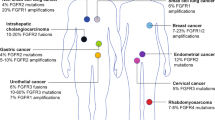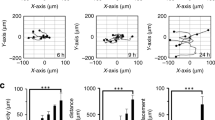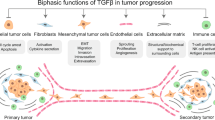Abstract
The b isoform of fibroblast growth factor receptor 2, FGFR2b/FGFR2-IIIb/Ksam-IIC1/KGFR, a tyrosine kinase receptor, is expressed in a wide variety of epithelia and is downregulated in several human carcinomas including prostate, salivary and urothelial cell carcinomas. FGFR2b has been shown to inhibit growth in tumour cell lines derived from these carcinomas. Here, we investigated the molecular mechanisms underlying the inhibition of human urothelial carcinoma cell growth following FGFR2b expression. Using a nylon DNA array, we analysed the gene expression profile of the T24 bladder tumour cell line, transfected or not with a construct encoding FGFR2b. The expression of FGFR2b in T24 cells decreased insulin-like growth factor (IGF)-II mRNA levels. This decrease was correlated with a decrease in IGF-II secretion and may have been responsible for the observed inhibition of cell growth because the addition of exogenous IGF-II restored growth rates to normal levels. Using SU5402, an inhibitor of FGFR tyrosine kinase activity, and a kinase dead mutant of the receptor, FGFR2b Y659F/Y660F, we also demonstrated that the growth inhibition and decrease in IGF-II secretion induced by FGFR2b did not require tyrosine kinase activity. Finally, we demonstrated the involvement of the distal carboxy-terminal domain of the receptor in decreasing IGF-II expression and inhibiting T24 cell growth, as Ksam-IIC3, a variant of FGFR2b carrying a short carboxy-terminus, neither downregulated IGF-II nor inhibited cell proliferation. Our data suggest that FGFR2b inhibits the growth of bladder carcinoma cells by reducing IGF-II levels via its carboxy-terminal domain, independent of its tyrosine kinase activity.
This is a preview of subscription content, access via your institution
Access options
Subscribe to this journal
Receive 50 print issues and online access
$259.00 per year
only $5.18 per issue
Buy this article
- Purchase on Springer Link
- Instant access to full article PDF
Prices may be subject to local taxes which are calculated during checkout





Similar content being viewed by others
Abbreviations
- FGFR:
-
fibroblast growth factor receptor
- FGF:
-
fibroblast growth factor
- IGF:
-
insulin-like growth factor
- RT–PCR:
-
reverse transcription–polymerase chain reaction
- FCS:
-
foetal calf serum
References
Basilico C and Moscatelli D . (1992). Adv. Cancer Res., 59, 115–165.
Bellusci S, Grindley J, Emoto H, Itoh N and Hogan BL . (1997). Development, 23, 4867–4878.
Berger W, Setinek U, Mohr T, Kindas-Mugge I, Vetterlein M, Dekan G, Eckersberger F, Caldas C and Micksche M . (1999). Int. J. Cancer, 3, 415–423.
Billerey C, Chopin D, Aubriot-Lorton MH, Ricol D, Gil Diez de Medina S, Van Rhijn B, Bralet MP, Lefrere-Belda MA, Lahaye JB, Abbou CC, Bonaventure J, Zafrani ES, van der Kwast T, Thiery JP and Radvanyi F . (2001). Am. J. Pathol., 6, 1955–1959.
Bordeaux MC, Forcet C, Granger L, Corset V, Bidaud C, Billaud M, Bredesen DE, Edery P and Mehlen P . (2000). EMBO J., 15, 4056–4063.
Brazma A, Hingamp P, Quackenbush J, Sherlock G, Spellman P, Stoeckert C, Aach J, Ansorge W, Ball CA, Causton HC, Gaasterland T, Glenisson P, Holstege FC, Kim IF, Markowitz V, Matese JC, Parkinson H, Robinson A, Sarkans U, Schulze-Kremer S, Stewart J, Taylor R, Vilo J and Vingron M . (2001). Nat. Genet., 4, 365–371.
Broët P, Richardson S and Radvanyi F . (2002). J. Comput. Biol., 4, 671–683.
Cappellen D, De Oliveira C, Ricol D, de Medina S, Bourdin J, Sastre-Garau X, Chopin D, Thiery JP and Radvanyi F . (1999). Nat. Genet., 23, 18–20.
Chellaiah AT, McEwen DG, Werner S, Xu J and Ornitz DM . (1994). J. Biol. Chem., 15, 11620–11627.
Diez de Medina SG, Chopin D, El Marjou A, Delouvee A, LaRochelle WJ, Hoznek A, Abbou C, Aaronson SA, Thiery JP and Radvanyi F . (1997). Oncogene, l4, 323–330.
Ezzat S, Zheng L, Zhu XF, Wu GE and Asa SL . (2002). J. Clin. Invest., 1, 69–78.
Feng S, Wang F, Matsubara A, Kan M and McKeehan WL . (1997). Cancer Res., 23, 5369–5378.
Finch PW, Cunha GR, Rubin JS, Wong J and Ron D . (1995). Dev. Dyn., 2, 223–240.
Finch PW, Rubin JS, Miki T, Ron D and Aaronson SA . (1989). Science, 4919, 752–755.
Freeman KW, Gangula RD, Welm BE, Ozen M, Foster BA, Rosen JM, Ittmann M, Greenberg NM and Spencer DM . (2003). Cancer Res., 19, 6237–6243.
Ishii H, Yoshida T, Oh H, Yoshida S and Terada M . (1995). Mol. Cell. Biol., 7, 3664–3671.
Itoh H, Hattori Y, Sakamoto H, Ishii H, Kishi T, Sasaki H, Yoshida T, Koono M, Sugimura T and Terada M . (1994). Cancer Res., 12, 3237–3241.
Johnson DE, Lu J, Chen H, Werner S and Williams LT . (1991). Mol. Cell. Biol., 9, 4627–4634.
Johnson DE and Williams LT . (1993). Adv. Cancer Res., 60, 1–41.
Lorenzi MV, Castagnino P, Chen Q, Chedid M and Miki T . (1997). Oncogene, 7, 817–826.
Matsubara A, Kan M, Feng S and McKeehan WL . (1998). Cancer Res., 7, 1509–1514.
McKeehan WL, Wang F and Kan M . (1998). Prog. Nucleic Acid Res. Mol. Biol., 59, 135–176.
Mehlen P, Rabizadeh S, Snipas SJ, Assa-Munt N, Salvesen GS and Bredesen DE . (1998). Nature, 6704, 801–804.
Miki T, Bottaro DP, Fleming TP, Smith CL, Burgess WH, Chan AM and Aaronson SA . (1992). Proc. Natl. Acad. Sci. USA, 1, 246–250.
Mohammadi M, Dikic I, Sorokin A, Burgess WH, Jaye M and Schlessinger J . (1996). Mol. Cell. Biol., 16, 977–989.
Mohammadi M, Dionne CA, Li W, Li N, Spivak T, Honegger AM, Jaye M and Schlessinger J . (1992). Nature, 6388, 681–684.
Mohammadi M, Honegger AM, Rotin D, Fischer R, Bellot F, Li W, Dionne CA, Jaye M, Rubinstein M and Schlessinger J . (1991). Mol. Cell. Biol., 10, 5068–5078.
Morrison RS, Yamaguchi F, Saya H, Bruner JM, Yahanda AM, Donehower LA and Berger M . (1994). J. Neurooncol., 3, 207–216.
Myoken Y, Myoken Y, Okamoto T, Kan M, McKeehan WL, Sato JD and Takada K . (1996). Int. J. Cancer, 5, 650–657.
Naimi B, Latil A, Fournier G, Mangin P, Cussenot O and Berthon P . (2002). Prostate, 3, 245–252.
Ornitz DM and Itoh N . (2001). Genome Biol., 3, Reviews 3005.1–3005.12.
Ornitz DM, Xu J, Colvin JS, McEwen DG, MacArthur CA, Coulier F, Gao G and Goldfarb M . (1996). J. Biol. Chem., 25, 15292–15297.
Peters KG, Marie J, Wilson E, Ives HE, Escobedo J, Del Rosario M, Mirda D and Williams LT . (1992). Nature, 6388, 678–681.
Powers CJ, McLeskey SW and Wellstein A . (2000). Endocr. Relat. Cancer, 7, 165–197.
Ricol D, Cappellen D, El Marjou A, Gil-Diez-de-Medina S, Girault JM, Yoshida T, Ferry G, Tucker G, Poupon MF, Chopin D, Thiery JP and Radvanyi F . (1999). Oncogene, 51, 7234–7243.
Rubin JS, Bottaro DP, Chedid M, Miki T, Ron D, Cheon G, Taylor WG, Fortney E, Sakata H, Finch PW and LaRochelle WJ . (1995). Cell Biol. Int., 5, 399–411.
Sakaguchi K, Lorenzi MV, Matsushita H and Miki T . (1999). Oncogene, 40, 5497–5505.
Volm M, Koomagi R, Mattern J and Stammler G . (1997). Eur. J. Cancer, 4, 691–693.
Ware LB and Matthay MA . (2002). Am. J. Physiol. Lung Cell. Mol. Physiol., 5, 924–940.
Wilkie AO, Morriss-Kay GM, Jones EY and Heath JK . (1995). Curr. Biol., 5, 500–507.
Xiao S, Nalabolu SR, Aster JC, Ma J, Abruzzo L, Jaffe ES, Stone R, Weissman SM, Hudson TJ and Fletcher JA . (1998). Nat. Genet., 1, 84–87.
Yamaguchi F, Saya H, Bruner JM and Morrison RS . (1994). Proc. Natl. Acad. Sci. USA, 2, 484–488.
Yamasaki M, Miyake A, Tagashira S and Itoh N . (1996). J. Biol. Chem., 27, 15918–15921.
Yayon A, Zimmer Y, Shen GH, Avivi A, Yarden Y and Givol D . (1992). EMBO J., 5, 1885–1890.
Zetter BR . (1998). Annu. Rev. Med., 49, 407–424.
Zhang Y, Wang H, Toratani S, Sato JD, Kan M, McKeehan WL and Okamoto T . (2001). Proc. Natl. Acad. Sci. USA, 20, 11336–11340.
Acknowledgements
We would like to thank Dr Yutaka Hattori, Dr Masaaki Terada and Dr Teruhiko Yoshida for providing the Ksam-IIC1/FGFR2b and Ksam-IIC3 plasmids, and Dr Sylvia Richardson for fruitful discussion. This work was supported by the CNRS, the Bio-ingénierie 2001 programme from the French Ministry of Education and Research (Biogen74 project) and the Ligue Contre le Cancer (laboratoire associé).
Author information
Authors and Affiliations
Corresponding author
Rights and permissions
About this article
Cite this article
Bernard-Pierrot, I., Ricol, D., Cassidy, A. et al. Inhibition of human bladder tumour cell growth by fibroblast growth factor receptor 2b is independent of its kinase activity. Involvement of the carboxy-terminal region of the receptor. Oncogene 23, 9201–9211 (2004). https://doi.org/10.1038/sj.onc.1208150
Received:
Revised:
Accepted:
Published:
Issue Date:
DOI: https://doi.org/10.1038/sj.onc.1208150
Keywords
This article is cited by
-
FGF10 mitigates doxorubicin-induced myocardial toxicity in mice via activation of FGFR2b/PHLDA1/AKT axis
Acta Pharmacologica Sinica (2023)
-
The combined action of the intracellular regions regulates FGFR2 kinase activity
Communications Biology (2023)
-
Inhibition of fibroblast growth factor receptor 1: influence on tympanic membrane wound healing in rats
European Archives of Oto-Rhino-Laryngology (2012)
-
The role of fibroblast growth factor receptor 2b in skin homeostasis and cancer development
The EMBO Journal (2007)



